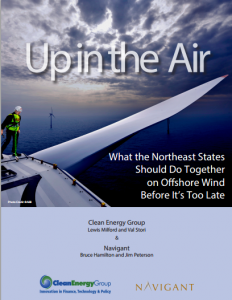Full Title: Up in the Air: What the Northeast States Should Do Together on Offshore Wind Before It’s Too Late
Author(s): Lewis Milford, Val Stori, Bruce Hamilton, and Jim Peterson
Publisher(s): Clean Energy Group & Navigant
Publication Date: January 1, 2015
Full Text: Download Resource
Description (excerpt):
According to the latest news, the country’s first proposed offshore wind project, Cape Wind, might never be built. Despite the best efforts of Massachusetts state officials to support the market for years, the disappointing news highlights a stark conclusion: current offshore wind policy isn’t working. While the Cape Wind project floundered amidst fierce local opposition, the project’s difficulties highlight a larger policy problem—it is difficult, if not impossible, for any single state to jumpstart the offshore wind industry. With the Northeast’s keystone project in limbo, only a few small projects might be built. Going forward, there is no solid pipeline of large projects to prove the economic and dnvironmental benefits of this technology and bring it to scale. The bottom line is that a new policy approach must be put in place to support a robust offshore wind industry in the United States. To be effective, that approach must rely on multi-state collaboration. Offshore wind will only become cost competitive and reach its true potential if the states in the Northeast region act together to help create a market for the technology. The current, go-italone, single-state policy approach has failed.1 Without effective collaboration among the states, a market for offshore wind in the Northeast will not develop and the few small projects in development might well be the last. It is that simple. This paper takes up the challenge of multi-state policy collaboration on offshore wind. It does the following:
• It shows the strong regional economic opportunities for offshore wind in the Northeast.
• It shows the multiple regional environmental benefits of a growing offshore wind market.
• It details the many challenges and barriers to a strong regional market, and then lists
actions Northeast states could take together to build this market—from setting regional procurement targets to developing joint financing and development mechanisms to concerted supply chain development.
• It details specific policy measures states could adopt together to build out this market, including creation of multi-state buyers’ networks and bargaining agents to purchase offshore wind power on behalf of multiple states.
• It then proposes a regional collaborative process for the states to use to consider these
measures and to decide whether to pursue offshore wind as a regional no-carbon resource.
While hopeful, this paper does not minimize the challenges. It notes that offshore wind is currently an expensive power resource, much as solar PV technology was twenty years ago. Since that time, policy measures, business models, and incentives—all targeted directly to solar technology—have brought precipitous drops in solar prices to customers. As a result of those concerted policies, in many regions of the country, solar has become an affordable, financeable, and commercially viable source of energy.
